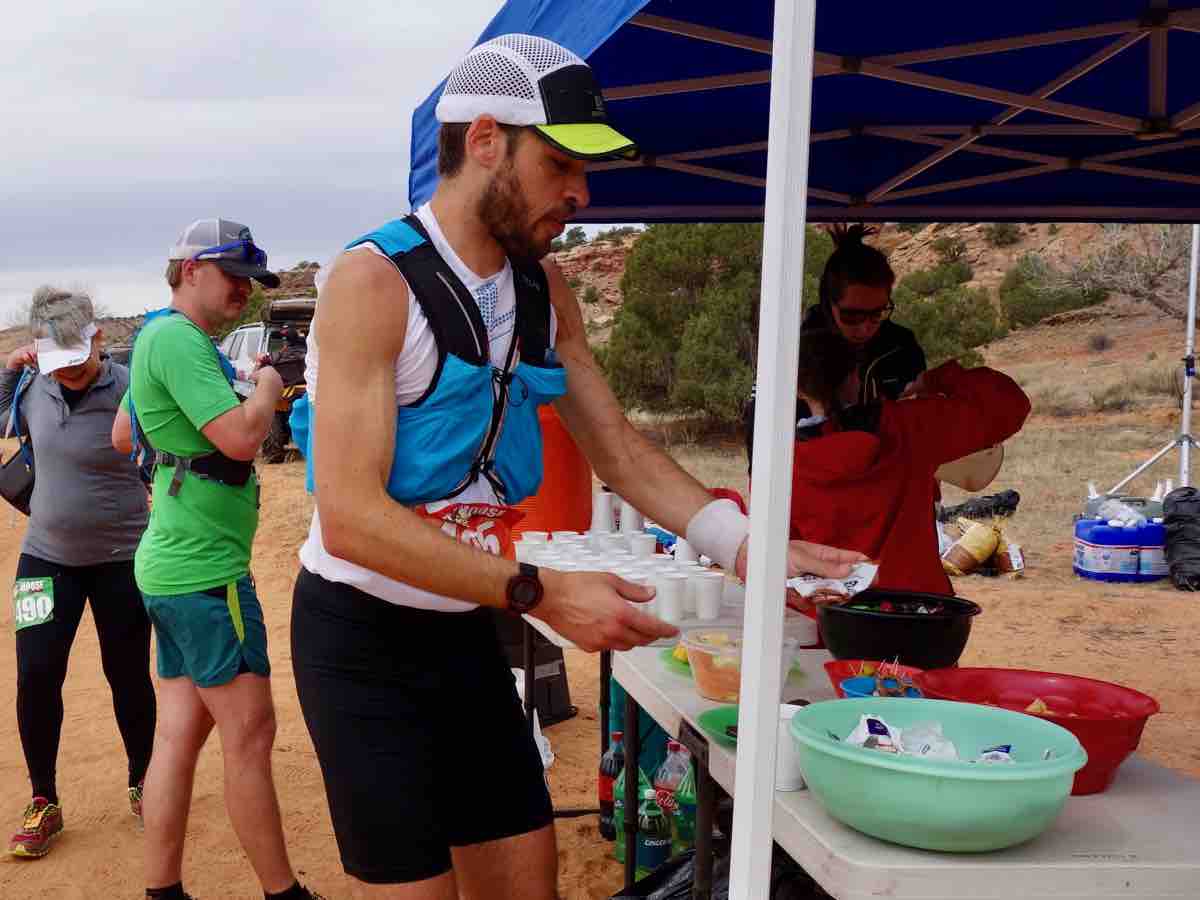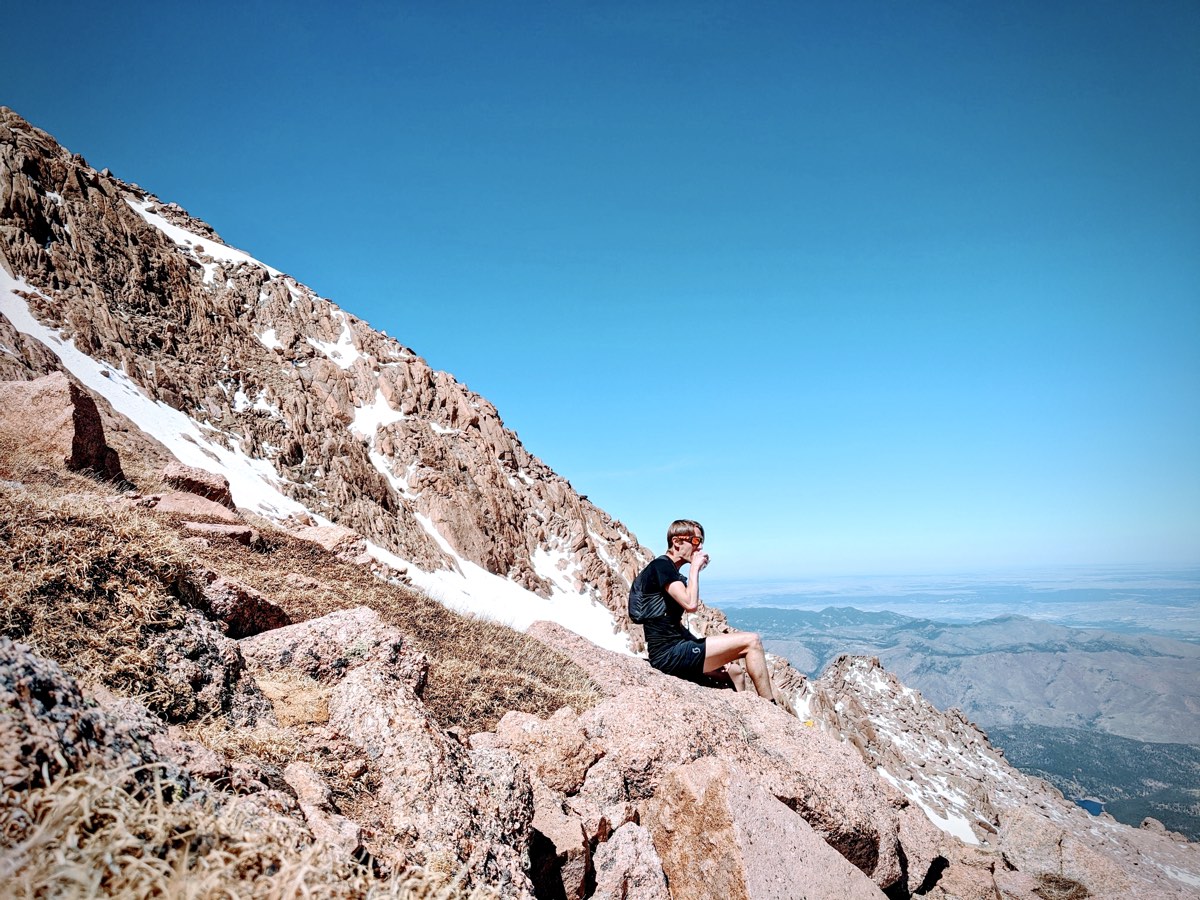The value of eating during long-duration exercise is well established. The article Fuel up: An Introduction to Fueling for Trail Running here on iRunFar is a helpful introduction to the calories and carbohydrates needed to fuel long trail runs. This information is extremely helpful, but as many runners have found, following through on those guidelines is difficult. The vertical oscillation of running and its impact on the gut along with a variety of other obstacles make the act of consuming enough calories during long runs and races a challenge in itself.
I have experimented with all types of eating strategies while running. I ran my first Pikes Peak Ascent, a 13-mile race that climbs 7,800 vertical feet to the summit of Pikes Peak, in 2007 with two energy gels tucked into the waistband of my shorts. The gels bounced with every step I took and the edges of the packets ended up cutting the skin on my waist. I finished with a neat set of cuts that burned with every drop of sweat.
More recently, while training for my first 100-mile race, I tried to eat rice-and-egg balls during a long run. That experiment ended with me choking so hard on the rice grains that they shot out of my nose, and I quickly learned that I couldn’t eat rice while breathing heavily.
Over the years, there have been improvements in running gear and nutrition, but many runners still tell horror stories of sour stomachs and late-night aid-station scenes straight out of the movie, “The Exorcist.” Successful ultrarunners have not only done the training needed to run long distances, but they have also developed individualized strategies to adequately fuel their runs. What all this means is that nutrition for long-distance running is incredibly individual, and this article offers you a few tips for figuring out what works for you.
Eat What You Enjoy
In my early days of trail running, I loved gels. I could stomach pretty much every flavor under the sun and be happy doing it. After gallons of maltodextrin-based products, my tastes changed. I could no longer stomach gels. Even a small amount would leave me gagging.
I started to experiment with other types of sugar and foods that were more appetizing to me. I now use either solid foods or liquids and don’t always stick to the typical engineered running foods. I know that I can pretty much always stomach a Twix or some M&M’s, so I eat them a lot, especially in 10-plus-hour races. At the end of the day, calories are calories, and keeping them down is the most important thing. Planning your food around your flavor preferences can be an effective way of taking in more calories and keeping them down.
Train How You Race
We have all heard the old saying that we shouldn’t try anything new on race day. The same goes for race-day nutrition. When I tried out rice balls on my training run, I quickly found out that those wouldn’t work for me. Without that experience, I could have found myself halfway through my 100-mile race with rice coming out of my nose.
Finding out what works for you and doing it repeatedly in training is extremely important. Besides finding out what types of foods you feel comfortable eating, it is also important to practice how you plan on eating them. When I plan out my race strategy, I try to pinpoint certain downhills or flats that I can use to eat. Trying to eat when I’m breathing hard on an uphill just doesn’t work, so if I can decide ahead of time where I plan on eating, I can consume more and keep myself accountable to eat the calories I have planned.
Take Your Time
The benefits of consuming enough calories during a race far outweigh a few extra minutes spent eating. It can be easy to get caught up in the moment and want to leave an aid station as soon as possible, but if that means cutting corners on your race nutrition, then you are shooting yourself in the foot. Although I try to run and eat as much as possible when I’m racing, I sometimes find myself needing to walk for a bit in order to eat my planned food. It might be hard to do in the moment, but those few minutes lost by walking are well worth it in the long run.
I have also found that eating small amounts of food over longer periods makes it much easier to handle food while running. One of my favorite strategies is to dilute a few gels in a 250-milliliter softflask and take small sips over the course of an hour or more. I can handle those small sips far more easily than trying to consume an entire 100-calorie gel at a time. It also helps to avoid the dreaded sticky fingers that come along with opening and eating gels.

Chris Mocko grabbing some gels from an aid station at the 2017 Behind the Rocks 50 Mile. Photo: iRunFar
Plan for Your Stomach
We all have our favorite foods that we eat while running. When I am planning out my race-day nutrition, I save my favorite items for later in the race. Saving a few of my favorites for the second half gives me something to look forward to, and it mixes up the flavor profile of my race nutrition. Even with solid preparation and nutrition training, I can almost guarantee I won’t be excited to keep eating after 50 miles of running. Being realistic and anticipating that feeling can help us plan the best foods for those moments.
Because I know there will almost always be a moment of nausea in long races, I also bring along a couple of Pepto Bismol LiquiCaps. Those are my go-to when all else has failed but I need to keep eating.
You Are an Experiment of One
Developing your ability to eat successfully on the run can be the difference between a poor race experience and a great one. Dialing in your nutrition strategies takes time and experimentation, and should be just as much of a focus as all of the accumulated training. Pay attention to what works, what tastes good, and make a plan ahead of time to consume your calories in the race. These are simple steps that are sometimes neglected, but they can make a major difference in longer races. Remember to keep eating, and keep running!
Call for Comments
- What strategies have you developed to help get in the nutrition you need during your long runs and races?
- What nutrition mistakes have you made in the past, and what hasn’t worked for you?

